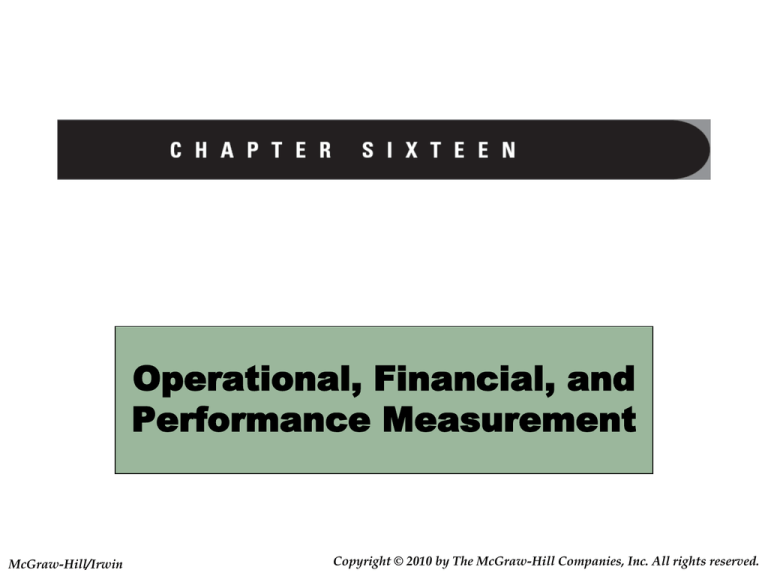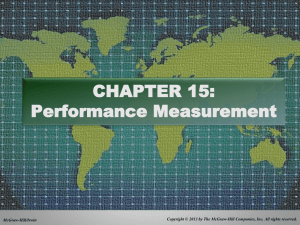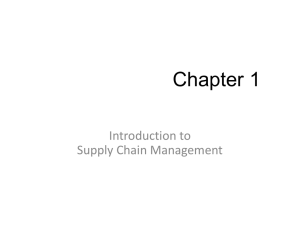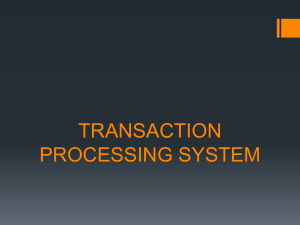
Operational, Financial, and
Performance Measurement
McGraw-Hill/Irwin
Copyright © 2010 by The McGraw-Hill Companies, Inc. All rights reserved.
Overview of operational and financial
performance measurement
• Measurement system
objectives
• Operational
assessment
• Financial assessment
“If you don’t measure it,
you can’t manage it.”
16-2
Measurement system objectives related to
logistical operations
• Monitoring system performance by establishment
of appropriate metrics to track and report
• Controlling system performance by having
appropriate standards of performance relative to
metrics being monitored
• Directing employee focus on system performance
through motivation and reward
• Improving shareholder value through superior
logistics performance
16-3
The Balanced Scorecard is a comprehensive
system of performance assessment
Figure 16.1 The Balanced Scorecard
16-4
Measurement focus using a balance
scorecard approach
• Financial perspective
– Profitability and return on
investment
• Internal operations
perspective
– Process quality, efficiency and
productivity
• Customer perspective
– Logistics service, quality and
satisfaction
• Innovation and learning
perspective
– Process improvement,
benchmarking and human
resource development
16-5
Operational assessment
• Functional perspectives
• Measuring customer
accommodation
• Determining appropriate
metrics
• Supply chain
comprehensive metrics
• Benchmarking
16-6
Functional perspective on logistics measures
includes these major categories
•
•
•
•
•
Cost
Customer service
Quality
Productivity
Asset management
16-7
Cost is the most direct reflection of logistics
performance
• Typically measured in total dollars spent
• Total logistics cost (aka total landed cost)
– Sum of order processing + inventory + transportation +
warehousing and materials handling + facility network
• Few organizations have ability to measure total cost
• Common to report cost as a
– Percentage of sales volume
• E.g. transportation cost as 15% of sales volume
– Cost per unit of volume
• E.g. loading cost as $5.50 per order
16-8
Customer service requires specific measures for
each element of the basic service platform
• Availability
– Organization’s fill rate
•
•
•
•
Item fill rate
Line fill rate
Value fill rate
Order fill rate
• Operational performance
– Average order cycle time is
average number of days elapsed
between order receipt and
delivery to customer
– Order cycle consistency
– On-time delivery
16-9
Quality measures often include service reliability
performance
• Accuracy of work activities
performed
• Damage frequency is the ratio
of number of damaged units to
the total number of units
• Number of customer returns of
damaged or defective goods
• Number of instances when
information is not available on
request
• Number of instances when
inaccurate information is
discovered
16-10
Productivity is measured in terms of output of
goods compared with quantities of inputs
• Labor productivity
– Units shipped per employee
– Units received per
employee
• Equipment downtime
16-11
Asset management considers utilization of capital
investments in facilities, equipment and inventory
• Facilities and equipment
– Capacity utilization
• E.g. warehouse utilization of 80% is not shipping all it is capable of shipping
– Downtime is the percentage of hours that equipment is not utilized
• E.g. forklift with a 2% annual downtime
• Inventory
– Inventory turnover rate is most common measure of performance
– Days of supply is the amount available to meet forecasted sales volume
• E.g. 50 days of supply (100 units per day forecast and 5000 units on hand)
• Return on assets and return on investment
16-12
Inventory turnover rate is measured differently by
different types of firms
• Vast majority of firms use this
metric
• Some retail firms use this
metric
• This metric is used for products
whose cost or selling price
changes significantly during
relatively short periods of time
– E.g. gasoline inventory
Critical that average inventory use as
many data points as possible
16-13
Example of common metrics by category
Table 16.1 Typical Performance Metrics
16-14
Measuring customer accommodation requires an
additional set of metrics
• Perfect order measures the effectiveness of the
overall integrated logistical performance
– Ratio of perfect orders to the total number of orders
completed during the same time period
• Absolute performance provides a better
indication of how a firm’s performance impacts
customers
– “To us, 99.5 percent on-time delivery would mean that
on a typical day, over 5,000 customers received late
orders.”
• Customer satisfaction measurement requires
monitoring, measuring and collecting information
from the customer
16-15
Illustration of framework use showing metric
2 is closer to measurement need
Figure 16.2 Illustration of Measurement Framework
16-16
Supply chain comprehensive metrics
• Cash-to-cash conversion time
– Time required to convert a dollar
spent on inventory into a dollar of
sales revenue
• Inventory days of supply
– Calendar days of sales available
based on recent sales activity
• Dwell time
– Ratio of days inventory sits idle to
the days it is productively used or
positioned
• On-shelf in-stock percentage
– Percentage of time a product is
available on the shelf in a store
• Total supply chain cost
– Sum of costs across all firms in
the supply chain
• Supply chain response time
– Time required for all firms to
recognize a fundamental shift in
demand, internalize that finding,
replan, and adjust output to meet
that demand
16-17
Illustration of supply chain total cost
extending beyond an individual firm
Figure 16.3 Total Supply Chain Cost
16-18
Benchmarking makes management aware of stateof-the-art business practice
• Critical aspect of performance measurement
– “Are we staying competitive?”
– Considers metrics and processes
• Which organizations should we benchmark against?
– Internal groups are easier to identify
• Johnsons & Johnson has 150+ business units with ample opportunity to
share best practices
• Provides little information about performance against the competition
– Nonrestricted benchmarking compares metrics and processes to
best practices regardless of where the practice is found
• Belief that learning is possible from any firm with outstanding performance
16-19
High-achieving firms are more involved in
benchmarking than average-achieving firms
Table 16.2 Performance Benchmarking Differential
16-20
Financial assessment is needed to link supply
chain performance to financial results
• Critical tools for financial
assessment
– Segmentation of data
• By channel, territory,
customer, product, and
supplier
– Cost-revenue analysis
– Strategic profit model
16-21
Cost-revenue analysis is needed to provide a
financial view of integrated logistics
• Accounting deficiencies
make this difficult
• 3 approaches are available
to identify and control
logistics expenses
– Contribution
– Net profit
– Activity based costing
16-22
Accounting practices to prepare financial
statements create some deficiencies
• Costs are aggregated on a
standard account basis rather
than activity basis
• Inbound freight expense is
deducted from gross sales
• Outbound freight is reported as
an operating expense
• Freight is not reported as a
specific cost
– i.e. Products purchased on a
delivered price basis
• Failure to specify and assign
inventory cost
16-23
Contribution analysis requires all costs be
identified as fixed or variable
• Fixed costs are those that do not directly change
with volume
• Variable costs are those that change as a result of
volume
• Direct costs are those specifically incurred
because of the existence of the segment of analysis
– E.g. product, customer, channel
• Indirect costs exist because of more than one
segment of business
16-24
Example of contribution analysis
Table 16.3 Contribution Margin Income Statement for Two Customers
16-25
Net profit analysis requires all operating costs be
charged or allocated to an operating segment
• Each segment must be
allocated its fair share of
costs
• Example from Table 16.3
would require indirect fixed
cost of $41,000 to be
allocated to each segment
– E.g. allocate based on
sales volume
• Disagreements arise in
determining how to
allocate indirect costs
– Allocations are arbitrary
and may result in
misleading financial
assessment
– But, many indirect
expenses are not fixed
• Rather they rise and fall
based on business demand
of operating segments
16-26
Activity-based costing is a partial solution to
arbitrary allocations
• Activity-based costing (ABC)
suggests costs be traced to
activities
– Activities are then related to
product, process or customer
segments
• Biggest challenge with the ABC
approach is identifying the
activities, related expenses and
drivers of expense
16-27
Strategic profit model shows relationship of
income and balance sheet to ROA
• Return on investment
(ROI) is critical measure of
financial success
– Return on net worth
(RONW) measures
profitability of funds
invested by owners
– Return on assets (ROA)
measures profitability
generated by managing
operational assets
16-28
Illustration of strategic profit model with
example data
Figure 16.4 Strategic Profit Model
16-29
Illustration of strategic profit model with
example data
Figure 16.4 Strategic Profit Model
16-30
Illustration of strategic profit model with
example data
Figure 16.4 Strategic Profit Model
16-31
Illustration of strategic profit model with
example data
Figure 16.4 Strategic Profit Model
16-32
Illustration of strategic profit model with
example data
Figure 16.4 Strategic Profit Model
16-33
Illustration of strategic profit model with
example data
Figure 16.4 Strategic Profit Model
16-34
Illustration of strategic profit model with
example data
Figure 16.4 Strategic Profit Model
16-35
Illustration of strategic profit model with
example data
Figure 16.4 Strategic Profit Model
16-36
Illustration of strategic profit model with
example data
Figure 16.4 Strategic Profit Model
16-37
Illustration of strategic profit model with
example data
Figure 16.4 Strategic Profit Model
16-38
16-39
16-40
Two fundamental ways to improve return on
assets
• Manage net profit margin
improvements
– Net profit margin is net profit
divided by net sales
– Measures portion of each sales
dollar that is kept by the firm
• Manage asset turnover
improvements
– Asset turnover is ratio of total
sales divided by total assets
– Measures efficiency of
management utilization of assets
16-41
Applications of the strategic profit model (SPM)
• Model is very adaptable to a
spreadsheet
• Can use SPM in combination
with other methods to examine
ROA for customer or product
segments
– Table 16.4 provides an example
– Other segment profitability and
ROI analyses can be conducted
• Very useful framework for
relating logistics activities to
the overall financial objectives
of the organization
16-42
Product A vs Product B
Table 16.4 CMROI for Two Products
16-43
Product A vs Product B
Table 16.4 CMROI for Two Products
16-44
Product B contributes a higher return even though
its gross margin is lower
Table 16.4 CMROI for Two Products
16-45
Example showing ROA improvement if inventory
cost is reduced to $300
Figure 16.5 Strategic Profit Model (Inventory Reduction)
16-46
Requirements for financial reporting provide more
supply chain visibility to management
• Sarbanes-Oxley Act of 2002 (SOX)
– Section 404 requires an internal control report to be filed along with corporate
annual report
• Firms must have internal measurement capabilities that comply with
SEC requirements
• SOX requires disclosure of all off-balance-sheet liabilities that have
material effect on financial reports
– Vendor-managed inventories
– Long-term purchase agreements
– Slotting allowances
• Also required to report any event that may have material effect on
financial reports
– E.g. shipments with long lead times that may be held a international border
16-47











